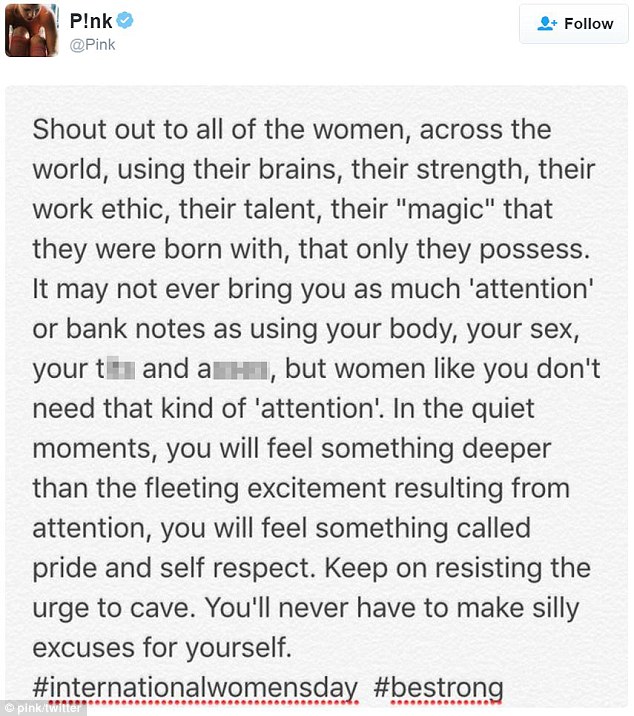
Recently, Kim Kardashian West posted a nude selfie on twitter. I’m sure most of you have seen the photo, but if not, she is standing in front of a mirror naked, covered only by two black bars. The caption reads, ‘When you’re like I have nothing to wear LOL‘.
And people lost their minds.
Other celebrities were quick to express their views. Chloe Moretz argued that we should teach young girls that women have more to offer than naked bodies. Piers Morgan wanted Kim Kardashian to put her clothes back on. Bette Midler seemed to be suggesting that we had seen too much of Kim’s naked body. And Pink, although not referring directly to Kim Kardashian, suggested that there is more worth to be found in women using brains, strength, work ethic, talent and “magic”, and indicated that this is associated with more pride and self respect:

This is just the latest example of ‘slut-shaming’ of an attractive woman who takes off her clothes. Miley Cyrus has been vilified for wearing very little and for unashamedly displaying her sexuality. Sinead O’Connor famously sent her a condescending letter suggesting that she shouldn’t walk around naked because it makes women “…prey for animals and less than animals…” and that she is worth more than her body or sexual appeal. After Rihanna wore a very revealing dress to an awards ceremony, TLC suggested that she didn’t need to be naked all of the time. And beautiful model and actress Emily Ratajkowski was subject to very harsh criticism for dancing topless in Robin Thicke & Pharrell’s infamous Blurred Lines video (she has written an excellent essay about how we define sexy here).

Frequently slut-shaming is attributed to a purported tendency for men to ‘objectify’ the female body and to measure the worth of women in terms of how they look. However, whilst some men do slut-shame women, that explanation is not consistent with the extent to which women engage in this behaviour towards other women. Feminists debate whether displays of the naked female body and female sexuality are empowering, or whether they equate the value of women with how they look, and pander to male desire. The latter view appears to be used as a justification for self-righteous slut-shaming, whereby it is suggested that valuing oneself in terms of appearance is shallow and degrading, and seen as having less worth than intelligence, personality and success.
I disagree with the view that these attributes are necessarily superior to appearance. Female physical attractiveness is by no means only skin deep; as I argued in another blog post, it provides adaptively useful information about attributes such as health, fertility, good genes and even intelligence itself. And it is precisely because physical attractiveness does carry such value that attractive women are slut-shamed for displaying it. Isn’t it interesting that when women post naked photographs of what many consider imperfect but more realistic bodies, they are often hailed as brave and empowering, rather than derogated and slut-shamed?
Why do women engage in slut-shaming of attractive women who display their bodies and their sexuality? Women have evolved a tendency to compete for the ‘best’ mates because acquiring a partner with good genes who was able to invest in offspring would have increased their reproductive success in the ancestral environment. Whilst men would have often competed for mates directly, for example, using physical aggression, this was more risky for women. A woman who sustained physical injury risked her fertility and compromised the survival chances of her offspring, who would have been very dependent on her. This meant that there was a selection pressure on women to avoid direct aggression where possible and, consistent with this, we found that women show much greater fear of physical harm and have better inhibitory control. They are therefore able, for example, to inhibit their anger to a greater extent than men and thereby avoid physical aggression.
This meant that women needed an alternative means of competing for mates in the ancestral environment. Women primarily compete by epigamic display – the presentation of attractiveness and mate quality to the opposite sex. Ultimately this is why women often invest so much in their appearance, and it is the ultimate motivation behind many selfies, naked or otherwise. Not only does this form of mate competition reduce the risk of injury compared to aggressive, physical competition, it is better suited to the mate competition needs of women because male mate preferences are heavily focussed on female physical attractiveness for the reasons described above – it indicates health, fertility and good genes.

However, epigamic display also serves to deter rivals by the demonstration of mate quality. And this is why the most attractive women are more likely to be subject to slut-shaming as a means of trying to damage their perceived mate quality, reduce their success in mate competition and increase the success of their rivals. Slut-shaming is a form of indirect (non-face-to-face) aggression. Indirect aggression may be used as a mate competition tactic when epigamic display is unlikely to be successful or competition for mates is high. It also avoids some of the risks associated with direct, physical aggression, and it is often extremely effective in damaging physically attractive rivals. It relies on another key aspect of male mate preferences – preference for indicators of faithfulness. Whilst indicators of promiscuity are likely to be attractive to men seeking short-term partners since they may indicate availability, the opposite is true for men seeking long-term partners. Men value indicators of fidelity in long-term partners due to the need to avoid cuckoldry (unknowingly raising another man’s child as a consequence of female infidelity) when investing in offspring.
This means that when women compete for long-term partners, casting aspersions on the sexual reputation of rivals is a powerful weapon. If a woman is physically attractive, she may display her mate quality and is likely to be successful in attracting a high quality partner. However, other women can damage the perceived mate quality of an attractive rival by claiming that her display of attractiveness indicates promiscuity. Condemning this display can also serve to enhance a woman’s own mate quality by establishing her as (apparently) less likely to be promiscuous.
The irony of this is that slut-shaming is a form of aggression which panders as much to male mate preferences as epigamic display in nude selfies because men value indicators of faithfulness in long-term partners.
The power of slut-shaming in damaging perceived mate quality has been demonstrated in studies which have interviewed adolescent girls about the factors which lead to physical fighting. One study found that fights amongst inner-city girls are often triggered by threats to sexual reputation. Another study found that the last remark made before a physical fight broke out between girls was often ‘slut’ or ‘slag’. When asked in another study (reported here) about the reasons for this, one girl remarked: “If someone slags you off – calls you a tart or something you’ve got to be able to do something about it“. This demonstrates that challenges to sexual reputation are deemed serious enough to justify physical aggression, with all of the risks that entails for women.
Likewise, claims that intelligence, personality and success have more value than displays of physical attractiveness may also be (ultimately) a form of indirect aggression designed to reduce the effectiveness of epigamic display, and to reduce the apparent worth of physically attractive women. Qualities such as personality and intelligence are important and they provide useful information about mate quality too, but logically the argument that they are of greater value than physical attractiveness does not stand up. Like physical attractiveness, intelligence and personality are very variable and highly heritable, so why should women be valued more for possessing high levels of intelligence or ‘positive’ personality traits than for physical attractiveness?
We will continue to see slut-shaming of attractive women because these psychological mechanisms designed to allow women to compete for mates are as deeply ingrained in human nature as the mechanisms which result in men competing for mates, and competing for status to aid the acquisition of mates. It is likely that many women genuinely believe that they are right to condemn Kim Kardashian, yet they may also be utilising a different mechanism designed for mate competition themselves. In behaving in this way, however, women contribute to the maintenance of a sexual double standard, whereby displays of male sexuality are deemed acceptable, whilst displays of female sexuality are used to devalue women.

I would be very interested in talking to you further and perhaps interviewing you for my podcast. Please check out my site and if it’s something that might interest you, you can reach out via the contact page or my email address below. Your identity will be fully protected if that is what you are looking for, as I note there is no direct means of contact on your blog.
LikeLike